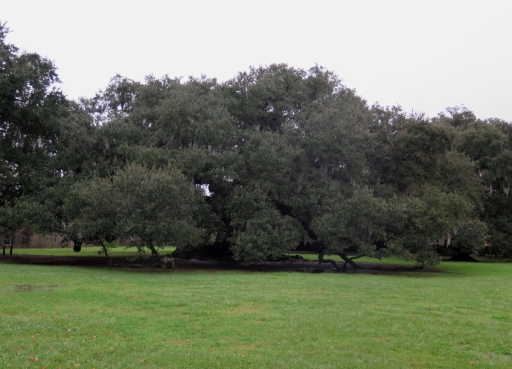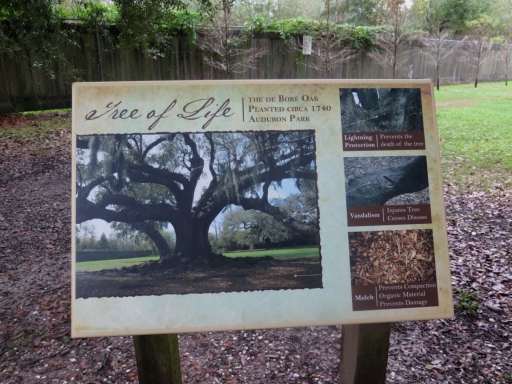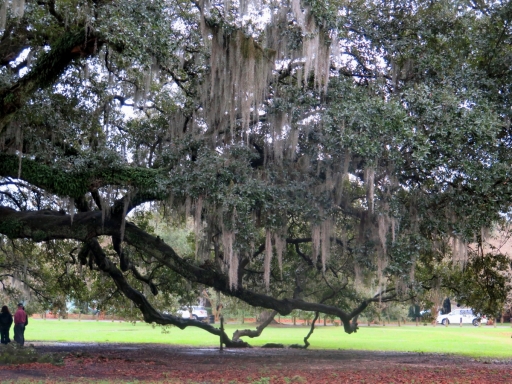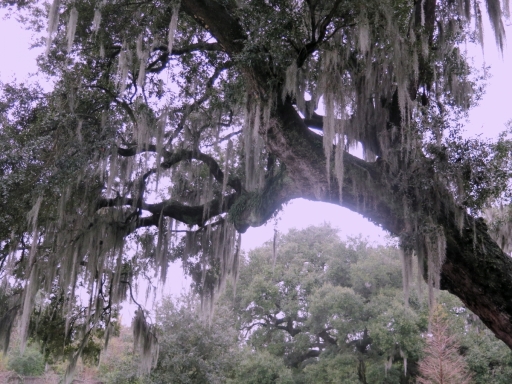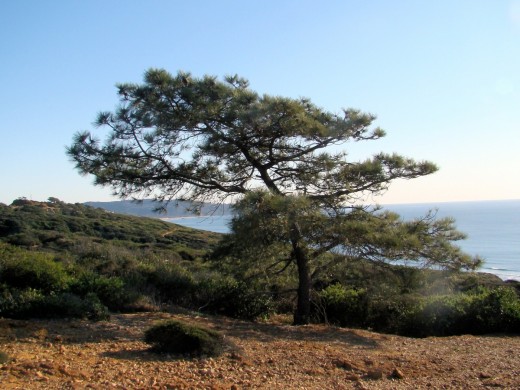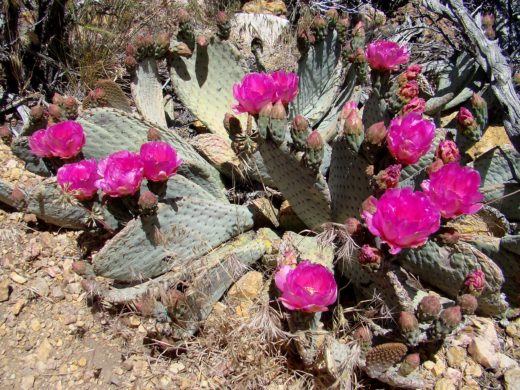Tree of Life in New Orleans Audubon Park
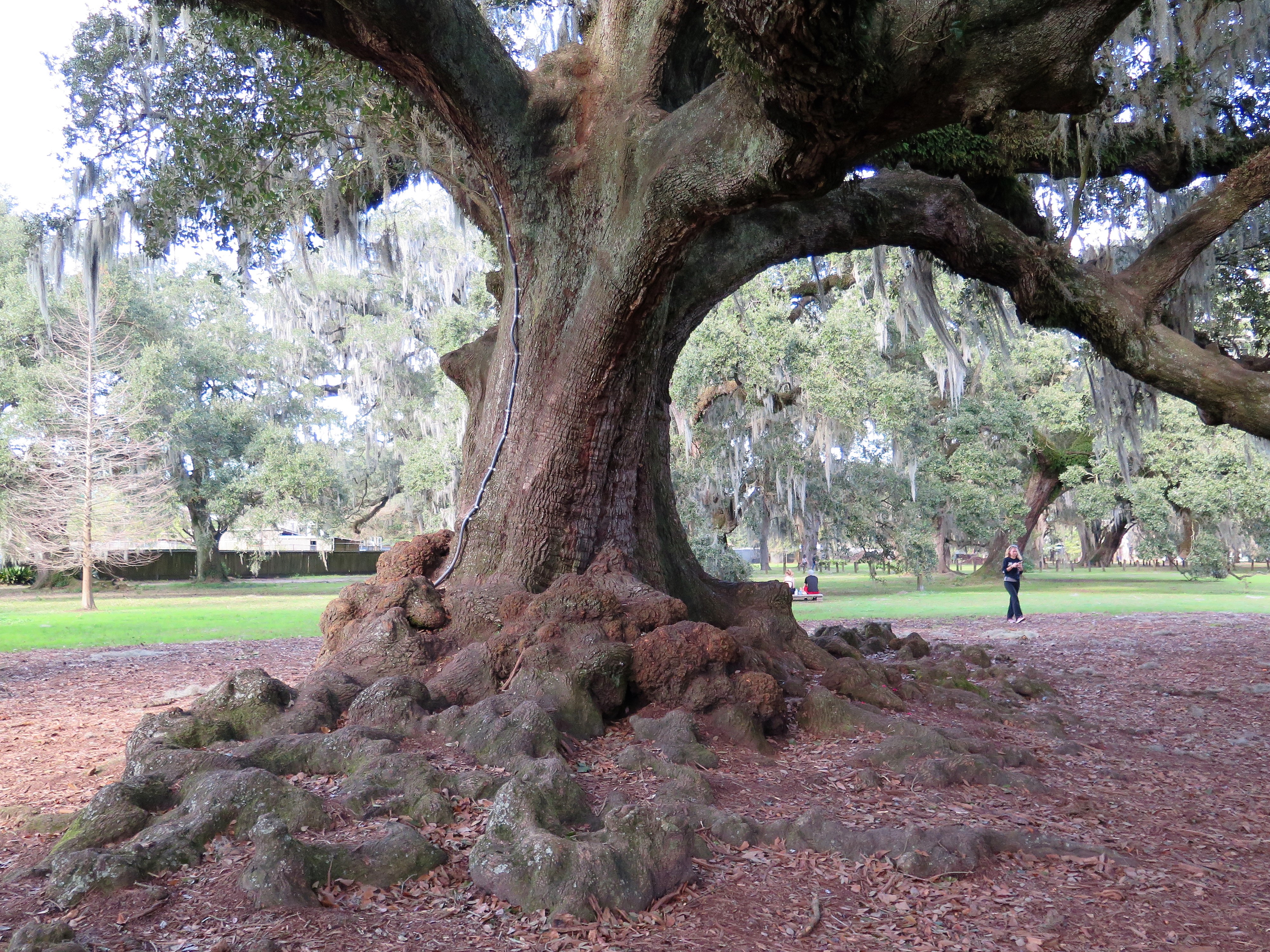
Giant, majestic, mysterious and stately are adjectives which describe live oak trees found throughout the southern United States. This past weekend we visited Audubon Park in New Orleans, Louisiana, where one of these trees resides. The “Tree of Life” or the Etienne de Boré Oak was planted around 1740.
We took a few photos and enjoyed the immense nature of the tree. Weddings are sometimes held under the tree or folks just come to visit. Audubon Park is also home to the Audubon Zoo in New Orleans. Occasionally a giraffe will peak over the fence to stare at folks who visit the tree. We arrived in the late afternoon. From the noises and squawking, I guess that was suppertime for the zoo animals who were more interested in eating than watching us. The “Tree of Life” is 35 feet in circumference at the base and its branches reach out 160 feet. The tree is almost 300 years old.
Live oak trees, Quercus Virginiana, are almost evergreen, shredding their leaves briefly in the spring. They cannot survive freezing temperatures and thus are found only in the South. They are extremely sturdy and can live to be 500 years-of-age. The oldest known tree, Seven Sisters tree, is 1200 years old. The long tap root and spreading canopy of branches and roots help the trees withstand the stress of hurricanes, storms, winds and floods. The trees grow outwards as well as up and often the branches touch the ground making a majestic canopy.
The tree, now in the heart of New Orleans, is located on what was originally an extensive sugar plantation of French planter, Jean Etienne de Boré. In 1795 Jean Etienne de Boré was the first person to successfully plant sugar cane in Louisiana and make cane sugar. Two Spaniard exiles from Santo Domingo helped with this. Jean Etienne de Boré was also the first mayor of New Orleans.
In 1938, Dr. Edwin Lewis Stephens began the “Live Oak Tree Society.” The only criteria for membership is that you are a live oak tree. The “Tree of Life” was number 13 on the list of 43 original inductee trees. Dr. Edwin Lewis Stephens was the first president of Southwestern Louisiana Institute which has been renamed the University of Louisiana in Lafayette. The Live Oak Tree Registry recognizes live oak trees of a certain size and age and now lists 7868 trees. The Live Oak Society’s goal is preservation and promotion of live oak trees and is operated under the auspices of the Louisiana Garden Club Federation, Inc. (www.lgcfinc.org/live-oak-society.html. Copyright © Louisiana Garden Club Federation, Incorporated. 2015)
Live oak trees are a part of our culture. It is always sad when I see the trees cut down which happened several years ago when an entire long row of the trees along a highway were cut down to widen the road. There is a beautiful canopy row of the trees at Oak Alley Plantation in Vacherie, Louisiana. It’s beautiful–wish I had a photo for this post. If you visit Louisiana, it’s worth a stop to see the plantation and trees.
Spanish moss often hangs from the branches of the massive live oak trees. Spanish moss is not a moss or parasite but a flowering plant (angiosperm) in the family Bromeliaceae (the bromeliads). While Spanish moss does not kill the tree or host, it does slow down the host’s growth. About a year ago I took care of a 90+-year-old Cajun lady in the hospital who was from a remote area of southern Louisiana. She spoke no English. Interestingly, she never went to school. When I asked why; the family responded that her father needed her help for work to make a living. What was family’s occupation? The family collected and sold Spanish moss. This most likely was in the 1920’s. Probably the Spanish moss was sold to Henry Ford and other auto makers who used it for mattress stuffing in their auto seats. The cypress shipping boxes were also dissembled in Detroit and used as running boards for the cars.
The trees are mysterious and expansive. Here the roots of the tree reach out. The Evangeline Oak in St. Martinville, Louisiana, was made famous in Henry Wadsworth Longfellow’s poem, “Evangeline.” I remember memorizing this poem in high school. The “Evangeline” tree stands on the bank of the Bayou Teche.
Nutrition is an important component of keeping these trees vital. Raymond Sumo, doctoral student at Southern University, completed his dissertation on the subject of the best mulch to use for maintaining the health of these trees. The topic and title of his dissertation research is: “The role of bio-based plant residues in sustainable nutrient management and the growth of live oak (Quercus Virginiana) saplings in urban landscape in Southeastern Louisiana,” Major Professor: Kamran Abdollahi, Ph.D.
Valuable research if we are to maintain our natural resources in future years.
